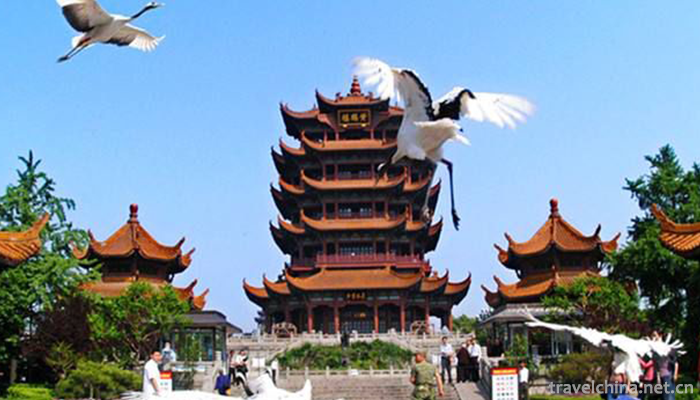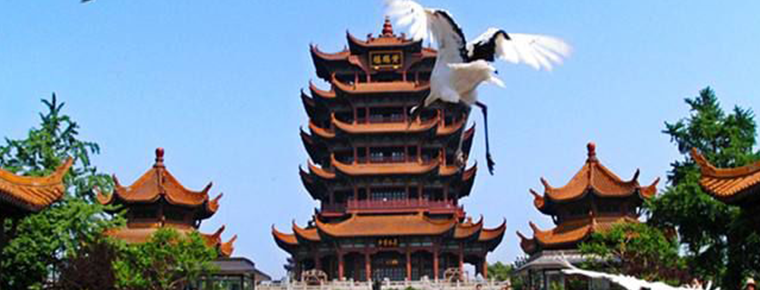Legend of Yellow Crane Tower
Legend of Yellow Crane Tower
The legend of the Yellow Crane Tower has a long history, and has been accompanied by the repeated destruction and construction of the Yellow Crane Tower, and continues to enrich and extend. Mysterious and strange, wonderful and graceful, euphemistic and moving. Not only has the extremely high historical and cultural value, but also has the distinctive literary value and the rich regional cultural color, which can be called the treasure of Wuhan folk culture. The legend of the Yellow Crane Tower comes from the folk, which contains profound and rich traditional cultural connotations such as immortal culture, folk wisdom and literati rhyme.
In 2011, the legend of the Yellow Crane Tower was approved by the State Council to be included in the third batch of national intangible cultural heritage list.
Historical origin
Towering in the Yellow Crane Tower of Snake Mountain in Wuchang, it enjoys the reputation of "the world's greatest scenery". It is also called "three famous buildings in the south of the Yangtze River" together with Yueyang Tower in Hunan Province and Tengwang Pavilion in Jiangxi Province. The Yellow Crane Tower was built in the second year of Wu Huangwu in the Three Kingdoms Period (223 AD). It is said that it was built for military purposes. Sun Quan built the building for the purpose of "governing the country by Wuchang" (the name of "Wuchang" comes from here). By the Tang Dynasty, its military nature gradually evolved into a famous scenic spot, where literati and ink travelers of all dynasties visited, leaving many well-known poems. Cui Hao, a poet of Tang Dynasty, wrote a song, "The former people have taken the Yellow Crane to the Yellow Crane Tower, where there is no spare Yellow Crane Tower." Yellow crane is gone forever, white clouds have been empty for thousands of years. Qingchuan calendar Hanyang tree, Fangcao Parrot Island. Where is the home at dusk? It's sad on the Yanbo River. It has become an absolute singer for thousands of years, making the Yellow Crane Tower more famous. The legend of building is beautiful. More than a thousand years ago, an old man surnamed Xin opened a hotel on Snake Mountain. He went up to the mountain every day to cut firewood. When he came back, he picked a good wood wedge from the wood and cut it into a smooth one. The poor man was puzzled. When he was cooking, he smoothly added a wooden wedge to the stove. Lu Ban sighed, "This is invaluable and will be useful in the future." On the 100th day, Lu Ban left a message: "When you can put thousands of daily goods, you can change your money." Then leave. Three years later, the Yellow Crane Tower was built on Snake Mountain, but it was inclined seriously and threatened to be destroyed. It wedged the crooked end and made craftsmen turn around in a hurry. The poor man chopped a wedge like a wedge, made up a hundred and went to market. When the architect saw this precious wedge, he was very interested and paid a lot of money to buy it. The poor man stood on the turtle hill facing the Yellow Crane Tower and threw away the wedges one by one. Ninety-nine wedges whistled across the Yangtze River and wedged firmly on the Yellow Crane Tower. Only one wooden wedge fell into the river, which was cut by the poor man. The Yellow Crane Tower is slightly inclined due to the lack of a wedge, but it will be all right for thousands of years.
By the first year of Yongtai in Tang Dynasty (A.D. 765), the Yellow Crane Tower had taken shape, which made many famous scholars in Jiangxia "travel and feast". However, there are frequent fires and wars, and Yellow Crane Tower has been built and abandoned repeatedly. The last "Qinglou" was built in Tongzhi seven years (AD 1868), destroyed in Guangxu ten years (AD 1884), and has not been rebuilt for nearly a hundred years.
In October 1981, the Huanghe Tower renovation project broke ground and was completed in June 1985. The main building is based on Tongzhi Building in Qing Dynasty, but it is taller and more magnificent. Using modern construction technology, the reinforced concrete frame imitates wood structure. The eaves are 5 stories, the top of the building is a cusp, the golden glazed tile roof is 51.4 meters high, the bottom edge is 30 meters wide, and the top edge is 18 meters wide. There are large murals, couplets and cultural relics on all floors of the building. A number of auxiliary buildings, such as bronze crane, pagoda, archway, porch, Pavilion and pavilion outside the building, set off the main building more magnificent. Upstairs overlooking the "extreme vision Chutianshu", not rolling the Yangtze River, the three towns have a panoramic view.
historical significance
The legend of Yellow Crane Tower shows the historical legend of Yellow Crane Tower in the form of traditional Chinese literature.
Since its establishment, the shape of Yellow Crane Tower has been different from Dynasty to dynasty, but all of them are tall, vigorous and full of personality. Compared with Yueyang Tower and Tengwang Pavilion, the plane design of Huanghe Tower is a set of octagons with four sides, which is called "all sides and all sides". These figures reveal the symbolic and ethical functions of numbers in ancient architectural culture. From the vertical view of the building, the eaves of each floor are directly related to the name of the building. They are like yellow cranes, and they are ready to fly. The whole building is exquisite and full of changeable charm and aesthetic feeling.
The Yellow Crane Tower has always been a place where "travel is bound to result, banquet is bound to result", and its popularity has been very strong. Nowadays, people regard it as a place of pleasure for sightseeing and visiting, or climbing upstairs to overlook, or playing by the water, or reciting poems and lyrics, or collecting orchids and ornaments to appreciate chrysanthemums. When a crop of people come in, you will know that the profound cultural origin, the magical attraction of beautiful legends is as far as Si.


-
1.Qiqu Mountain Scenic Area
Qiqu Mountain Scenic Spot is located about 9 kilometers north of Zitong County, Mianyang City, Sichuan Province. It is located at the southern end of Jianmen Shudao Scenic Spot.
Time 2018-12-17 -
2.Seoul Lake Park
Seoul Lake Park is located in Weiyang District of Xi'an City, Shaanxi Province. It is 200 meters west of the cross of Fengcheng 4th Road and Zhuhong Road. It was originally the Unity Reservoir
Time 2019-01-13 -
3.Yangba Subtropical Ecotourism Scenic Area
Yangba subtropical eco-tourism scenic spot is located in Yangba Town, south of Kangxian Town, Longnan City, Gansu Province, 84 kilometers away from the county town
Time 2019-03-02 -
4.Huaibei Bangzi Opera
Huaibei Bangzi Opera originally named Shahe Diao, also known as Shahe Bangzi, Anhui Bangzi Opera, and Henan Henan Henan Opera belong to a different genre, is popular in Anhui Province
Time 2019-05-04 -
5.Glass Firing Techniques
Glass firing technology, Beijing Mentougou District, Shanxi Province, local traditional handicraft, one of the national intangible cultural heritage.
Time 2019-05-14 -
6.Horse vaulting
Horse vaulting, a traditional sacrificial dance, is popular in Rudong, Jiangsu Province. It is a dance performed in sacrificing the "Dutian King" they believe in. Participants held "hor
Time 2019-06-21 -
7.Legend of Zhaos Orphans
Zhao's orphan legend is one of the folk legends in Shanxi Province. In the folk of Yuxian County, the legends about Zhao's orphans are handed down orally and orderly. Every year, there are more than 1
Time 2019-07-25 -
8.Anhui University Of Traditional Chinese Medicine
Anhui University of Chinese Medicine is located in Anhui. Jiangnan Labial teeth, Huai right A famous historical and cultural city called "the throat". Hefei For Anhui higher education revita
Time 2019-11-07 -
9.Shixiang Lake
Shixiang lake is named after Shixiang temple, an ancient temple in the lake area. It is said that it was the place where Yan Yan, a general of the Three Kingdoms, rode an elephant to heaven.
Time 2020-10-16 -
10.Introduction to Panzhihua
Panzhihua, a prefecture level city of Sichuan Province, is located in the southernmost end of Sichuan Province, 614 km away from Chengdu in the north, 273 km from Kunming in the South and Lijiang and Dali in the West; it is located in the central and southern section of Panxi Rift
Time 2020-12-14 -
11.Mianyang secondary industry
In 2019, the added value of industries above Designated Size in Mianyang will increase by 10.0%, 2.0 percentage points higher than the provincial average level, and the production and sales rate of Industrial Enterprises above designated scale
Time 2020-12-14 -
12.Geographical environment of Suining
Suining City is located in the middle of Sichuan Basin and the middle reaches of Fujiang River. It is between 105 ° 03 ′ 26 ″ - 106 ° 59 ′ 49 ″ E and 30 ° 10 ′ 50 ″ - 31 ° 10 ′ 50 ″ n.
Time 2020-12-16